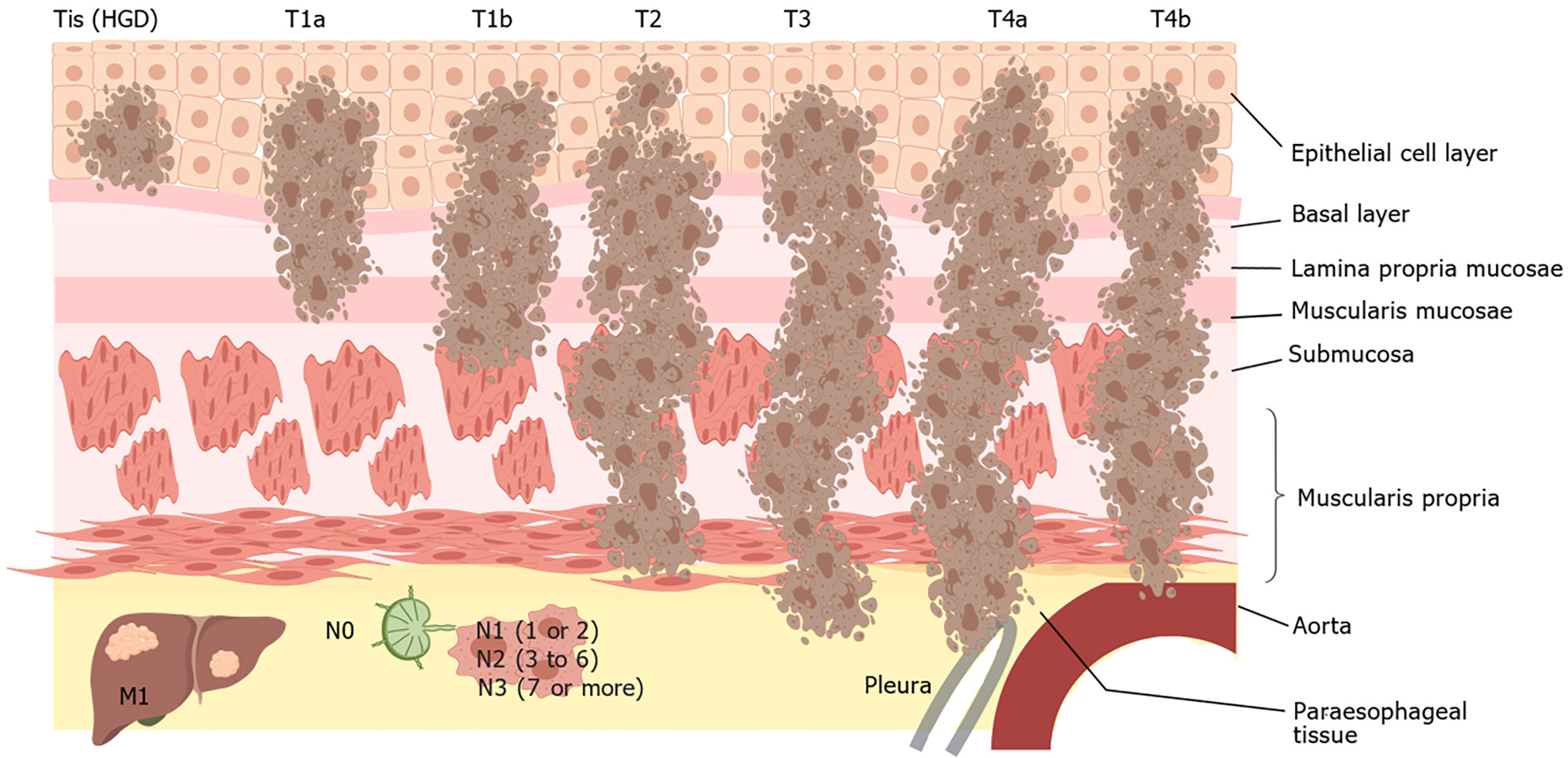Copyright
©The Author(s) 2024.
World J Gastrointest Oncol. Apr 15, 2024; 16(4): 1104-1118
Published online Apr 15, 2024. doi: 10.4251/wjgo.v16.i4.1104
Published online Apr 15, 2024. doi: 10.4251/wjgo.v16.i4.1104
Figure 1 Incidence and progression of esophageal squamous cell carcinoma.
The progression of esophageal squamous cell carcinoma in tissues and the corresponding TNM T stage refer to the condition of the primary tumor lesion, with increasing tumor volume, increasing depth of invasion and extent of involvement of adjacent tissues. TIS: High-grade dysplasia; T1: Cancer invading the lamina propria mucosae, muscularis mucosa, or submucosa and divided into T1a (cancer invading the lamina propria mucosae or muscularis mucosa) and T1b (cancer invading the submucosa); T2: Cancer invading the muscularis propria; T3: Cancer invading the adventitia; T4: Cancer invading local structures and classified as T4a (cancer invading adjacent structures such as the pleura) and T4b (cancer invading major adjacent structures such as the aorta). N stage refers to regional lymph node involvement. N0: No regional lymph node metastases, N1: 1-2 regional lymph node metastases, N2: 3-6 regional lymph node metastases, and N3: 7 or more regional lymph node metastases. M stage refers to distant metastases. M0: No distant metastases, M1: Distant metastasis. Citation: The figure was created by author using MedPeer. The authors have obtained the permission for figure using from the medpeer.cn (Supplementary material).
Figure 2 Molecular biology and epigenetics in early esophageal squamous cell carcinoma.
MiRNA: MicroRNA; LncRNA: Long-chain ncRNA. Citation: The figure was created by author using MedPeer. The authors have obtained the permission for figure using from the medpeer.cn (Supplementary material).
Figure 3 Tumorigenic properties of Fusobacteriumnucleatum and Porphyromonasgingivalis in early esophageal squamous cell carcinoma.
Microorganisms play an important role in early esophageal squamous cell carcinoma (ESCC), and people with low esophageal microbial richness and salivary microbial diversity may be more likely to progress to esophageal squamous dysplasia (a precursor to ESCC) and ESCC. Fusobacterium nucleatum promoted the early progression of ESCC by upregulating the expression of IL-32/PRTN3 and activating the PI3K/AKT signaling pathway. Porphyromonas gingivalis fimbriae upregulates TLR4/MyD88 expression, which in turn activates GARP-mediated TGFβ/Smad signaling, thereby promoting the occurrence and development of ESCC. Fn: Fusobacterium nucleatum; Pg: Porphyromonas gingivalis; FimA: Fimbriae. Citation: The figure was created by author using MedPeer. The authors have obtained the permission for figure using from the medpeer.cn (Supplementary material).
- Citation: Qi JH, Huang SL, Jin SZ. Novel milestones for early esophageal carcinoma: From bench to bed. World J Gastrointest Oncol 2024; 16(4): 1104-1118
- URL: https://www.wjgnet.com/1948-5204/full/v16/i4/1104.htm
- DOI: https://dx.doi.org/10.4251/wjgo.v16.i4.1104











